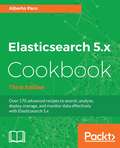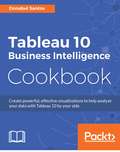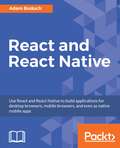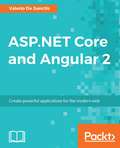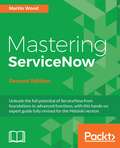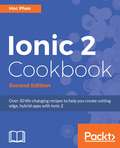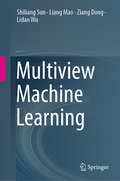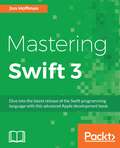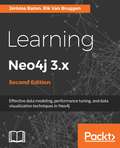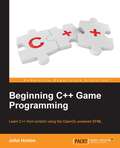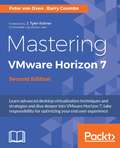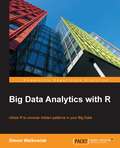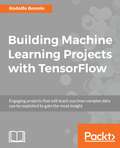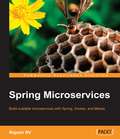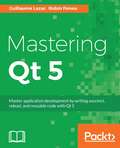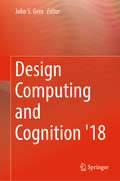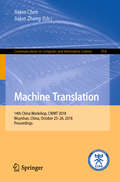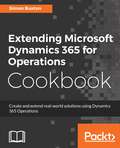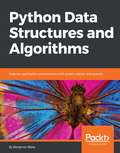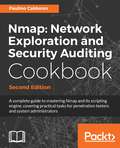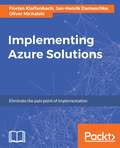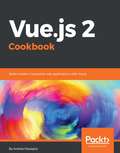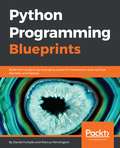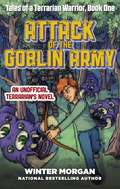- Table View
- List View
Elasticsearch 5.x Cookbook - Third Edition
by Alberto ParoOver 170 advanced recipes to search, analyze, deploy, manage, and monitor data effectively with Elasticsearch 5.x About This Book • Deploy and manage simple Elasticsearch nodes as well as complex cluster topologies • Write native plugins to extend the functionalities of Elasticsearch 5.x to boost your business • Packed with clear, step-by-step recipes to walk you through the capabilities of Elasticsearch 5.x Who This Book Is For If you are a developer who wants to get the most out of Elasticsearch for advanced search and analytics, this is the book for you. Some understanding of JSON is expected. If you want to extend Elasticsearch, understanding of Java and related technologies is also required. What You Will Learn • Choose the best Elasticsearch cloud topology to deploy and power it up with external plugins • Develop tailored mapping to take full control of index steps • Build complex queries through managing indices and documents • Optimize search results through executing analytics aggregations • Monitor the performance of the cluster and nodes • Install Kibana to monitor cluster and extend Kibana for plugins • Integrate Elasticsearch in Java, Scala, Python and Big Data applications In Detail Elasticsearch is a Lucene-based distributed search server that allows users to index and search unstructured content with petabytes of data. This book is your one-stop guide to master the complete Elasticsearch ecosystem. We'll guide you through comprehensive recipes on what's new in Elasticsearch 5.x, showing you how to create complex queries and analytics, and perform index mapping, aggregation, and scripting. Further on, you will explore the modules of Cluster and Node monitoring and see ways to back up and restore a snapshot of an index. You will understand how to install Kibana to monitor a cluster and also to extend Kibana for plugins. Finally, you will also see how you can integrate your Java, Scala, Python, and Big Data applications such as Apache Spark and Pig with Elasticsearch, and add enhanced functionalities with custom plugins. By the end of this book, you will have an in-depth knowledge of the implementation of the Elasticsearch architecture and will be able to manage data efficiently and effectively with Elasticsearch. Style and approach This book follows a problem-solution approach to effectively use and manage Elasticsearch. Each recipe focuses on a particular task at hand, and is explained in a very simple, easy to understand manner.
Tableau 10 Business Intelligence Cookbook
by Donabel SantosCreate powerful, effective visualizations to help analyze your data with Tableau 10 by your side About This Book * Cook your favorite Tableau 10 business intelligence recipe with the help of this easy-to-follow book * Build beautiful, interactive dashboards and visualizations in Tableau 10 that help you make informed decisions * This rich collection of independent recipes cover everything needed to become an advanced Tableau user and get an edge over other Tableau users Who This Book Is For This book is targeted to business, data, and analytics professionals who want to build rich interactive visualizations using Tableau. Familiarity with previous versions of Tableau would be helpful, but is not necessary. What You Will Learn * Become familiar with the Tableau interface * Build basic to more advanced charts with step-by-step recipes * Use filters, calculated fields, parameters, and actions to add interactivity to charts and dashboards * Prepare and transform data for analysis using Tableau's built-in tools and functions * Create effective and compelling dashboards and story points * Leverage Tableau's mapping capabilities to visualize location and shape data * Integrate analytics and forecasting to enhance data analysis * Get to know tips and tricks to work more quickly and effectively in Tableau * Increase your confidence and competence in creating rich, interactive visualizations in Tableau In Detail Tableau is a software tool that can speed up data analysis through its rich visualization capabilities, and help uncover insights for better and smarter decision making. This book is for the business, technology, data and analytics professionals who use and analyze data and data-driven approaches to support business operations and strategic initiatives in their organizations. This book provides easy-to-follow recipes to get the reader up and running with Tableau 10, and covers basic to advanced use cases and scenarios. The book starts with building basic charts in Tableau and moves on to building more complex charts by incorporating different Tableau features and interactivity components. There is an entire chapter dedicated to dashboard techniques and best practices. A number of recipes specifically for geospatial visualization, analytics, and data preparation are also covered. By the end of this book, you'll have gained confidence and competence to analyze and communicate data and insights more efficiently and effectively by creating compelling interactive charts, dashboards, and stories in Tableau. Style and approach This book is a collection of independent recipes that cover a wide range of options for data visualization on offer with Tableau. With the help of the recipes in this book, you can explore Tableau and pick the business intelligence solution that's best suited for your needs.
React and React Native
by Adam BoduchUse React and React Native to build applications for desktop browsers, mobile browsers, and even as native mobile apps About This Book • Build React and React Native applications using familiar component concepts • Dive deep into each platform, from routing in React to creating native mobile applications that can run offline • Use Facebook's Relay, React and GraphQL technologies, to create a unified architecture that powers both web and native applications Who This Book Is For This book is written for any JavaScript developer—beginner or expert—who wants to start learning how to put both of Facebook's UI libraries to work. No knowledge of React is needed, though a working knowledge of ES2015 will help you follow along better. What You Will Learn • Craft reusable React components • Control navigation using the React Router to help keep your UI in sync with URLs • Build isomorphic web applications using Node.js • Use the Flexbox layout model to create responsive mobile designs • Leverage the native APIs of Android and iOS to build engaging applications with React Native • Respond to gestures in a way that's intuitive for the user • Use Relay to build a unified data architecture for your React UIs In Detail React and React Native allow you to build cross-platform desktop and mobile applications using Facebook's innovative UI libraries. Combined with the Flux data architecture and Relay, you can now create powerful and feature-complete applications from just one code base! This book is split into three parts. The first part shows you how to start crafting composable UIs using React, from rendering with JSX and creating reusable components through to routing and creating isomorphic applications that run on Node. We then move on to showing you how to take the concepts of React and apply them to building Native UIs using React Native. You'll find out how to build responsive and streamlined UIs that can properly handle user interactions in a mobile environment. You'll also learn how to access device-specific APIs such as the geolocation API, and how to handle offline development with React Native. Finally, we'll tie all of these skills together and shows you how you can create React applications that run on every major platform. As well as understanding application state in depth, you'll learn how to leverage Relay to make feature-complete, data-driven web and native mobile applications. Style and approach Split into three major sections to help organize your learning, this hands-on, code-first book will help you get up to speed with React and React Native—the UI framework that powers Netflix, Yahoo, and Facebook.
ASP.NET Core and Angular 2
by Valerio De SanctisLearn how to connect ASP.NET Core and Angular 2 to build a powerful and dynamic applications from scratch with this guide to cutting-edge web development About This Book * Build a complete single page application with two of the most impressive frameworks in modern development * Find out how to bring together the capabilities and features of both Angular 2 and ASP.NET Core * From managing data, to application design, through to SEO optimization and security - take a comprehensive approach to building your next web project Who This Book Is For ASP.NET developers - find out how to bring Angular 2 into your development stack and extend your skillset so you can build even better single page applications. What You Will Learn * Find out how ASP.NET Core's and Angular 2's features perfectly complement each other * Learn how to set up the resources you need and configure the MVC 6 interface * Handle requests and actions using server-side and client-side Routing * Create the Data Model using Entity Framework Core * Learn how to use Angular 2 components and master directives * Implement a token-based authorization and authentication flow supporting external login providers such as Facebook, Google, Twitter and more * Create responsive, mobile-friendly views using Bootstrap and LESS * Setup and optimize your production environment using IIS and SQL Server * Secure your application against a diverse range of dangerous security threats In Detail Writing code is about striking a balance between maintainability and productivity--how quickly you can write it against how much more you have to write in the future. This is a guide to doing just that by combining the impressive capabilities of ASP.NET Core and Angular 2. It shows you how to successfully manage an API and use it to support and power a dynamic single-page application. We'll show you how to construct your data model and manage routing and redirects before wrapping it up and styling it, all with the help of ASP.NET and Angular 2. You'll also learn how to optimize your application for SEO, check and secure any vulnerabilities, implement a viable authentication mechanism and, last but not least, use the proper tools and strategies for successful deployment. From readable URIs to OData retrieval and authentication patterns, we'll make sure you have all the technical knowledge you need and, more importantly, bring it all together so you can focus on what's important: a high-quality application that performs for users. Style and approach More than just a technical manual, this guide takes you through the most important technical facets of developing with these two hugely popular frameworks and then demonstrates how to put those skills into practice. It's a book that recognizes that what's really important is the end product.
Mastering ServiceNow - Second Edition
by Martin WoodUnleash the full potential of ServiceNow from foundations to advanced functions, with this hands-on expert guide fully revised for the Helsinki version About This Book * Give your ServiceNow Helsinki implementation a powerful kick-start by understanding the deep capabilities of the platform, * Learn by doing with an extended, comprehensive example, creating a feature-rich, secure and automated application from the ground up * Interact with your whole organization by integrating with REST web services and build a custom Service Portal interface Who This Book Is For This book is aimed at advanced ServiceNow System Administrators and developers who would like to gain greater control of ServiceNow and its architecture. The book expects you to be new to ServiceNow, but have a good grounding in internet and computing technologies, like HTML, JSON, REST and database systems. Readers should be especially familiar with JavaScript, and be keen to extend and alter the platform. With this book, they will be able to develop a new application for their company. What You Will Learn * Build custom scoped applications that access the full ServiceNow API * Build a modern, responsive self-service interface with Service Portal * Design feature-rich, responsive, automated workflow systems * Design powerful data-driven applications * Control information flow and apply business logic with Business Rules * Write efficient and effective client-side JavaScript * Learn how to authenticate and secure Web Services * Integrate and exchange data with people and systems * Create and secure your systems with proper access control In Detail ServiceNow is a SaaS application that provides workflow form-based applications. It is an ideal platform for creating enterprise-level applications giving requesters and fulfillers improved visibility and access to a process. ServiceNow-based applications often replace email by providing a better way to get work done. The book steps through the main aspects of the ServiceNow platform, from the ground up. It starts by exploring the core architecture of ServiceNow, including building the right data structure. To add business logic and control data, and interactivity to user interaction, you will be shown how to code on both server and the client. You will then learn more about the power of tasks, events and notifications. The book will then focus on using web services and other mechanisms to integrate ServiceNow with other systems. Furthermore, you will learn how to secure applications and data, and understand how ServiceNow performs logging and error reporting. You will then be shown how to package your applications and changes, so they can be installed elsewhere and ways to maintain them easily. If you wish to create an alternative simple interface, then explore ways to make ServiceNow beautiful using Service Portal. By the end of the book, you will know the fundamentals of the ServiceNow platform, helping you be a better ServiceNow System Administrator or developer. Style and approach Explore how to implement business logic and automated workflows and write effective code by flexible choices for client-side scripting
Ionic 2 Cookbook - Second Edition
by Hoc PhanOver 30 life-changing recipes to help you create cutting edge, hybrid apps with Ionic 2 About This Book * Leverage Ionic 2 and its exciting new features to create cutting edge real-time apps * Work through simple recipes to address your problems directly and solve them effectively * Get examples at each step to guide you on your learning curve Who This Book Is For This book is for front end JavaScript developers who know the basics of JavaScript programming. No prior knowledge of Ionic is required to get the most of this book. What You Will Learn * Create custom UIs using Angular 2 directives * Make the best use of REST APIs to submit forms * Create beautiful animations and graphics in the application * Embed videos and other media into the app * Access native device functionalities such as a camera and maps using ngCordova * Theme the application based on the various platform styles available * Publish your application to a variety of platforms * Leverage Angular 2 events and Ionic-specific events to communicate In Detail Developing real-time apps is the need of the hour, and apps that deal with humongous amounts of user data and real-time information that needs to be updated frequently are in high demand. Currently, one of the most popular frameworks for this task is Ionic Framework, which is undergoing a major makeover. This book will get you started with Ionic and help you create Angular 2 components that interact with templates. From there, you'll work with Ionic components and find out how to share data efficiently between them. You'll discover how to make the best use of the REST API to handle back-end services and then move on to animating the application to make it look pretty. You'll learn to add in a local push notification in order to test the app. You'll work with Cordova to support native functionalities on both iOS and Android. From there, you'll get to grips with using the default themes for each platform as well as customizing your own. Finally, you'll see how best to deploy your app to different platforms. This book will solve all your Ionic-related issues through dedicated recipes that will help you get the best out of Ionic. Style and approach This book is a recipe-based solution to all your Ionic 2 related problems and will help you create cutting edge real-time apps with ease through simple-to-understand step-by-step recipes.
Multiview Machine Learning
by Shiliang Sun Liang Mao Ziang Dong Lidan WuThis book provides a unique, in-depth discussion of multiview learning, one of the fastest developing branches in machine learning. Multiview Learning has been proved to have good theoretical underpinnings and great practical success. This book describes the models and algorithms of multiview learning in real data analysis. Incorporating multiple views to improve the generalization performance, multiview learning is also known as data fusion or data integration from multiple feature sets. This self-contained book is applicable for multi-modal learning research, and requires minimal prior knowledge of the basic concepts in the field. It is also a valuable reference resource for researchers working in the field of machine learning and also those in various application domains.
Mastering Swift
by Jon HoffmanIf you are a developer that learns best by looking at, and working with, code, then this book is for you. A basic understanding of Apple's tools is beneficial but not mandatory.
Learning Neo4j 3.x - Second Edition
by Rik Van Bruggen Jerome BatonRun blazingly fast queries on complex graph datasets with the power of the Neo4j graph database About This Book • Get acquainted with graph database systems and apply them in real-world use cases • Use Cypher query language, APOC and other Neo4j extensions to derive meaningful analysis from complex data sets. • A practical guide filled with ready to use examples on querying, graph processing and visualizing information to build smarter spatial applications. Who This Book Is For This book is for developers who want an alternative way to store and process data within their applications. No previous graph database experience is required; however, some basic database knowledge will help you understand the concepts more easily. What You Will Learn • Understand the science of graph theory, databases and its advantages over traditional databases. • Install Neo4j, model data and learn the most common practices of traversing data • Learn the Cypher query language and tailor-made procedures to analyze and derive meaningful representations of data • Improve graph techniques with the help of precise procedures in the APOC library • Use Neo4j advanced extensions and plugins for performance optimization. • Understand how Neo4j's new security features and clustering architecture are used for large scale deployments. In Detail Neo4j is a graph database that allows traversing huge amounts of data with ease. This book aims at quickly getting you started with the popular graph database Neo4j. Starting with a brief introduction to graph theory, this book will show you the advantages of using graph databases along with data modeling techniques for graph databases. You'll gain practical hands-on experience with commonly used and lesser known features for updating graph store with Neo4j's Cypher query language. Furthermore, you'll also learn to create awesome procedures using APOC and extend Neo4j's functionality, enabling integration, algorithmic analysis, and other advanced spatial operation capabilities on data. Through the course of the book you will come across implementation examples on the latest updates in Neo4j, such as in-graph indexes, scaling, performance improvements, visualization, data refactoring techniques, security enhancements, and much more. By the end of the book, you'll have gained the skills to design and implement modern spatial applications, from graphing data to unraveling business capabilities with the help of real-world use cases. Style and approach A step-by-step approach of adopting Neo4j, the world's leading graph database. This book includes a lot of background information, helps you grasp the fundamental concepts behind this radical new way of dealing with connected data, and will give you lots of examples of use cases and environments where a graph database would be a great fit
Beginning C++ Game Programming
by John HortonLearn C++ from scratch using the OpenGL-powered SFMLAbout This BookThis book offers a fun way to learn modern C++ programming while building exciting 2D gamesThis beginner-friendly guide offers a fast-paced but engaging approach to game developmentDive headfirst into building a wide variety of desktop games that gradually increase in complexityIt is packed with many suggestions to expand your finished games that will make you think critically, technically, and creativelyWho This Book Is ForThis book is for those who have no C++ programming knowledge whatsoever and want to learn to build games or just use games as a more engaging way to learn C++. If you have aspirations of one day publishing a game on Steam or just want to have a load of fun while learning C++, then this book was written for you.What You Will LearnGet to know C++ from scratch while simultaneously learning about building gamesMake C++ game coding appear like it is something that any determined person can doGet a competent level knowledge of C++ programming.Build exciting games with a wide range of featuresGet ready to go and build your own unique gamesIn DetailThis book is all about offering you a fun introduction to the world of game programming and C++. It will begin by teaching you the programming basics such as variables, loops, and conditions using game-like mini apps.We then move on to build actual working games. Throughout the course of the book, you will learn to build three different styles of games comprising a frantic two-button-tapper, a zombie survival/shooter, and a multiplayer platformer. While building these games, you will learn some more C++ programming concepts such as OOP and data storage/complexity. We'll end by creating a multiplayer shooter game and will also introduce you to some of the advanced capabilities of C++ such as networking and advanced OOP.As the games gradually increase in complexity, you will explore some of the advanced capabilities of C++ as well as some exciting new game programming techniques.
Mastering VMware Horizon 7 - Second Edition
by Peter Von Oven Barry CoombsLearn advanced desktop virtualization techniques and strategies and dive deeper into VMware Horizon 7, take responsibility for optimizing your end user experience About This Book * Build better virtualized services for your users with VMware Horizon 7 * Take full advantage of Horizon's range of features for confidence and control in your virtualized solutions * Take responsibility for transforming your organization - this guide will get you started! Who This Book Is For Admins, architects... whatever your role, if you find virtualization a bit of a headache this book is for you. You'll go deep into VMware Horizon and see just what its capable of. It will take you to an advanced level, but at a pace that ensures you're always solving real-world problems. You'll need some experience in desktop management using Windows and Microsoft Office, and familiarity with Active Directory, SQL, Windows Remote Desktop Session Hosting, and VMware vSphere technology. What You Will Learn * Successfully configure Horizon 7 for the needs of your users * Find out how VMware is perfect for end-user computing delivering virtual desktops, session-based desktops, and hosted applications all from the same platform * Learn how to develop, and deploy a complete end-to-end solution * Discover how to optimize desktop OS images for virtual desktops * Build, optimize, and tune desktop operating systems to deliver a superior end-user experience * Explore the Horizon 7 infrastructure, so you can take full advantage of it! In Detail Desktop virtualization can be a bit of a headache. But VMware Horizon 7 changes all that. With a rich and adaptive UX, improved security and a range of useful features for storage and networking optimization, there's plenty to love. But to properly fall in love with it, you need to know how to use it. And that means venturing deeper into the software, taking advantage of its extensive range of features, many of which are underused and underpromoted. This guide will take you through everything you need to know to not only successfully virtualize your desktop infrastructure but also to maintain and optimize the infrastructure to keep all your users happy. We'll show you how to assess and analyze your infrastructure, and how to use that analysis to design a solution that meets your organizational and user needs. Once you've done that, you'll find out how to build your virtualized environment, before deploying your virtualized solution. But more than that, we'll also make sure you know everything you need to know about the full range of features on offer, including mobile cloud, so you can use them to take full control of your virtualized infrastructure. Style and approach Focusing on an end-user project, this useful, yet comprehensive guide will show you how to take full advantage of VMware's Horizon 7 solution and how to successfully implement it for your organization.
Big Data Analytics with R
by Simon WalkowiakUtilize R to uncover hidden patterns in your Big Data About This Book * Perform computational analyses on Big Data to generate meaningful results * Get a practical knowledge of R programming language while working on Big Data platforms like Hadoop, Spark, H2O and SQL/NoSQL databases, * Explore fast, streaming, and scalable data analysis with the most cutting-edge technologies in the market Who This Book Is For This book is intended for Data Analysts, Scientists, Data Engineers, Statisticians, Researchers, who want to integrate R with their current or future Big Data workflows. It is assumed that readers have some experience in data analysis and understanding of data management and algorithmic processing of large quantities of data, however they may lack specific skills related to R. What You Will Learn * Learn about current state of Big Data processing using R programming language and its powerful statistical capabilities * Deploy Big Data analytics platforms with selected Big Data tools supported by R in a cost-effective and time-saving manner * Apply the R language to real-world Big Data problems on a multi-node Hadoop cluster, e.g. electricity consumption across various socio-demographic indicators and bike share scheme usage * Explore the compatibility of R with Hadoop, Spark, SQL and NoSQL databases, and H2O platform In Detail Big Data analytics is the process of examining large and complex data sets that often exceed the computational capabilities. R is a leading programming language of data science, consisting of powerful functions to tackle all problems related to Big Data processing. The book will begin with a brief introduction to the Big Data world and its current industry standards. With introduction to the R language and presenting its development, structure, applications in real world, and its shortcomings. Book will progress towards revision of major R functions for data management and transformations. Readers will be introduce to Cloud based Big Data solutions (e.g. Amazon EC2 instances and Amazon RDS, Microsoft Azure and its HDInsight clusters) and also provide guidance on R connectivity with relational and non-relational databases such as MongoDB and HBase etc. It will further expand to include Big Data tools such as Apache Hadoop ecosystem, HDFS and MapReduce frameworks. Also other R compatible tools such as Apache Spark, its machine learning library Spark MLlib, as well as H2O. Style and approach This book will serve as a practical guide to tackling Big Data problems using R programming language and its statistical environment. Each section of the book will present you with concise and easy-to-follow steps on how to process, transform and analyse large data sets.
Building Machine Learning Projects with TensorFlow
by Rodolfo BonninEngaging projects that will teach you how complex data can be exploited to gain the most insight About This Book * Bored of too much theory on TensorFlow? This book is what you need! Thirteen solid projects and four examples teach you how to implement TensorFlow in production. * This example-rich guide teaches you how to perform highly accurate and efficient numerical computing with TensorFlow * It is a practical and methodically explained guide that allows you to apply Tensorflow's features from the very beginning. Who This Book Is For This book is for data analysts, data scientists, and researchers who want to increase the speed and efficiency of their machine learning activities and results. Anyone looking for a fresh guide to complex numerical computations with TensorFlow will find this an extremely helpful resource. This book is also for developers who want to implement TensorFlow in production in various scenarios. Some experience with C++ and Python is expected. What You Will Learn * Load, interact, dissect, process, and save complex datasets * Solve classification and regression problems using state of the art techniques * Predict the outcome of a simple time series using Linear Regression modeling * Use a Logistic Regression scheme to predict the future result of a time series * Classify images using deep neural network schemes * Tag a set of images and detect features using a deep neural network, including a Convolutional Neural Network (CNN) layer * Resolve character recognition problems using the Recurrent Neural Network (RNN) model In Detail This book of projects highlights how TensorFlow can be used in different scenarios - this includes projects for training models, machine learning, deep learning, and working with various neural networks. Each project provides exciting and insightful exercises that will teach you how to use TensorFlow and show you how layers of data can be explored by working with Tensors. Simply pick a project that is in line with your environment and get stacks of information on how to implement TensorFlow in production. Style and approach This book is a practical guide to implementing TensorFlow in production. It explores various scenarios in which you could use TensorFlow and shows you how to use it in the context of real world projects. This will not only give you an upper hand in the field, but shows the potential for innovative uses of TensorFlow in your environment. This guide opens the door to second generation machine learning and numerical computation - a must-have for your bookshelf!
Spring Microservices
by Rajesh RvIf you are a Spring developers and want to build cloud-ready, internet-scale applications to meet modern business demands, then this book is for you Developers will understand how to build simple Restful services and organically grow them to truly enterprise grade microservices ecosystems.
Mastering Qt 5
by Guillaume Lazar Robin PeneaMaster application development by writing succinct, robust, and reusable code with Qt 5 About This Book • Unleash the power of Qt 5 with C++14 • Integrate useful third-party libraries such as OpenCV • Package and deploy your application on multiple platforms Who This Book Is For This book will appeal to developers and programmers who would like to build GUI-based applications. Knowledge of C++ is necessary and the basics of Qt would be helpful. What You Will Learn • Create stunning UIs with Qt Widget and Qt Quick • Develop powerful, cross-platform applications with the Qt framework • Design GUIs with the Qt Designer and build a library in it for UI preview • Handle user interaction with the Qt signal/slot mechanism in C++ • Prepare a cross-platform project to host a third-party library • Build a Qt application using the OpenCV API • Use the Qt Animation framework to display stunning effects • Deploy mobile apps with Qt and embedded platforms In Detail Qt 5.7 is an application development framework that provides a great user experience and develops full-capability applications with Qt Widgets, QML, and even Qt 3D. This book will address challenges in successfully developing cross-platform applications with the Qt framework. Cross-platform development needs a well-organized project. Using this book, you will have a better understanding of the Qt framework and the tools to resolve serious issues such as linking, debugging, and multithreading. Your journey will start with the new Qt 5 features. Then you will explore different platforms and learn to tame them. Every chapter along the way is a logical step that you must take to master Qt. The journey will end in an application that has been tested and is ready to be shipped. Style and approach This is an easy-to-follow yet comprehensive guide to building applications in Qt. Each chapter covers increasingly advanced topics, with subjects grouped according to their complexity as well as their usefulness. Packed with practical examples and explanations, Mastering Qt contains everything you need to take your applications to the next level.
Design Computing and Cognition ’18
by John S. GeroThis is the proceedings of the Eighth International Conference on Design Computing and Cognition (DCC’18) held at the Polytecnico di Milano in Italy. This volume presents both advances in theory and applications and demonstrates the depth and breadth of design computing and design cognition. Design thinking, the label given to the acts of designing, has become a paradigmatic view that has transcended the discipline of design and is now widely used in business and elsewhere. As a consequence there is an increasing interest in design research. This volume contains papers that represent the state-of-the-art research and developments in design computing and design cognition. This book is of particular interest to researchers, developers and users of advanced computation in design and those who need to gain a better understanding of designing that can be obtained through empirical studies.
Machine Translation: 14th China Workshop, Cwmt 2018, Wuyishan, China, October 25-26, 2018, Proceedings (Communications in Computer and Information Science #954)
by Jiajun Chen Jiajun ZhangThis book constitutes the refereed proceedings of the 14th China Workshop on Machine Translation, CWMT 2018, held in Wuyishan, China, in October 2018. The 9 papers presented in this volume were carefully reviewed and selected from 17 submissions and focus on all aspects of machine translation, including preprocessing, neural machine translation models, hybrid model, evaluation method, and post-editing.
Extending Microsoft Dynamics 365 for Operations Cookbook
by Simon BuxtonHave the best tools at your fingertips to extend and maximize the efficiency of your business management About This Book • Follow practical and easy-to-grasp examples, illustrations and coding to make the most out of Dynamics 365 for Operations in your business scenario • Extend Dynamics 365 for Operations in a cost-effective manner by using tools you already have • Solve common business problems with the valuable features of Dynamics 365 for Operations Who This Book Is For This book is for those who are getting to grips with Dynamics 365 for Operations developers or those migrating from C# development. The guide includes information essential for new and experienced Dynamics 365 for Operations developers. What You Will Learn • Create enumerated and extended data types • Understand the importance of using patterns and frameworks while creating a unique concept for your solution • Service and deploy your code and packages to improve performance • Write and perform unit tests to automate the testing process • Design your security model and policies to provide code access privileges • Construct the UI and business logic to add Power BI to dashboards In Detail Dynamics 365 for Operations is the ERP element of Microsoft's new Dynamics 365 Enterprise Edition. Operations delivers the infrastructure to allow businesses to achieve growth and make better decisions using scalable and contemporary ERP system tools. This book provides a collection of “recipes” to instruct you on how to create—and extend—a real-world solution using Operations. All key aspects of the new release are covered, and insights into the development language, structure, and tools are discussed in detail. New concepts and patterns that are pivotal to elegant solution designs are introduced and explained, and readers will learn how to extend various aspects of the system to enhance both the usability and capabilities of Operations. Together, this gives the reader important context regarding the new concepts and the confidence to reuse in their own solution designs. This “cookbook” provides the ingredients and methods needed to maximize the efficiency of your business management using the latest in ERP software—Dynamics 365 for Operations. Style and approach The book takes a practical recipe-based approach, focusing on real-world scenarios and giving you all the information you need to build a strong Dynamics 365 for Operations implementation.
Python Data Structures and Algorithms: Write Complex And Powerful Code Using The Latest Features Of Python 3. 7, 2nd Edition
by Benjamin BakaImplement classic and functional data structures and algorithms using Python About This Book • A step by step guide, which will provide you with a thorough discussion on the analysis and design of fundamental Python data structures. • Get a better understanding of advanced Python concepts such as big-o notation, dynamic programming, and functional data structures. • Explore illustrations to present data structures and algorithms, as well as their analysis, in a clear, visual manner. Who This Book Is For The book will appeal to Python developers. A basic knowledge of Python is expected. What You Will Learn • Gain a solid understanding of Python data structures. • Build sophisticated data applications. • Understand the common programming patterns and algorithms used in Python data science. • Write efficient robust code. In Detail Data structures allow you to organize data in a particular way efficiently. They are critical to any problem, provide a complete solution, and act like reusable code. In this book, you will learn the essential Python data structures and the most common algorithms. With this easy-to-read book, you will be able to understand the power of linked lists, double linked lists, and circular linked lists. You will be able to create complex data structures such as graphs, stacks and queues. We will explore the application of binary searches and binary search trees. You will learn the common techniques and structures used in tasks such as preprocessing, modeling, and transforming data. We will also discuss how to organize your code in a manageable, consistent, and extendable way. The book will explore in detail sorting algorithms such as bubble sort, selection sort, insertion sort, and merge sort. By the end of the book, you will learn how to build components that are easy to understand, debug, and use in different applications. Style and approach The easy-to-read book with its fast-paced nature will improve the productivity of Python programmers and improve the performance of Python applications.
Nmap: Network Exploration and Security Auditing Cookbook - Second Edition
by Paulino CalderonOver 100 practical recipes related to network and application security auditing using the powerful Nmap About This Book • Learn through practical recipes how to use Nmap for a wide range of tasks for system administrators and penetration testers. • Learn the latest and most useful features of Nmap and the Nmap Scripting Engine. • Learn to audit the security of networks, web applications, databases, mail servers, Microsoft Windows servers/workstations and even ICS systems. • Learn to develop your own modules for the Nmap Scripting Engine. • Become familiar with Lua programming. • 100% practical tasks, relevant and explained step-by-step with exact commands and optional arguments description Who This Book Is For The book is for anyone who wants to master Nmap and its scripting engine to perform real life security auditing checks for system administrators and penetration testers. This book is also recommended to anyone looking to learn about network security auditing. Finally, novice Nmap users will also learn a lot from this book as it covers several advanced internal aspects of Nmap and related tools. What You Will Learn • Learn about Nmap and related tools, such as Ncat, Ncrack, Ndiff, Zenmap and the Nmap Scripting Engine • Master basic and advanced techniques to perform port scanning and host discovery • Detect insecure configurations and vulnerabilities in web servers, databases, and mail servers • Learn how to detect insecure Microsoft Windows workstations and scan networks using the Active Directory technology • Learn how to safely identify and scan critical ICS/SCADA systems • Learn how to optimize the performance and behavior of your scans • Learn about advanced reporting • Learn the fundamentals of Lua programming • Become familiar with the development libraries shipped with the NSE • Write your own Nmap Scripting Engine scripts In Detail This is the second edition of 'Nmap 6: Network Exploration and Security Auditing Cookbook'. A book aimed for anyone who wants to master Nmap and its scripting engine through practical tasks for system administrators and penetration testers. Besides introducing the most powerful features of Nmap and related tools, common security auditing tasks for local and remote networks, web applications, databases, mail servers, Microsoft Windows machines and even ICS SCADA systems are explained step by step with exact commands and argument explanations. The book starts with the basic usage of Nmap and related tools like Ncat, Ncrack, Ndiff and Zenmap. The Nmap Scripting Engine is thoroughly covered through security checks used commonly in real-life scenarios applied for different types of systems. New chapters for Microsoft Windows and ICS SCADA systems were added and every recipe was revised. This edition reflects the latest updates and hottest additions to the Nmap project to date. The book will also introduce you to Lua programming and NSE script development allowing you to extend further the power of Nmap. Style and approach This book consists of practical recipes on network exploration and security auditing techniques, enabling you to get hands-on experience through real life scenarios.
Implementing Azure Solutions: Deploy And Manage Azure Containers And Build Azure Solutions With Ease, 2nd Edition
by Florian Klaffenbach Jan-Henrik Damaschke Oliver MichalskiA practical guide that enhances your skills in implementing Azure solutions for your organization About This Book • Confidently configure, deploy, and manage cloud services and virtual machines • Implement a highly-secured environment and respond to threats with increased visibility • This comprehensive guide is packed with exciting practical scenarios that enable you to implement Azure solutions with ease Who This Book Is For This book is for IT architects, system and network admins, and DevOps engineers who are aware of Azure solutions and want to implement them for their organization. What You Will Learn • Implement virtual networks, network gateways, Site-to-Site VPN, ExpressRoute, routing, and network devices • Understand the working of different storage accounts in Azure • Plan, deploy, and secure virtual machines • Deploy and manage Azure Containers • Get familiar with some common Azure usage scenarios In Detail Microsoft Azure has numerous effective solutions that shape the future of any business. However, the major challenge that architects and administrators face are implementing these solutions appropriately. Our book focuses on various implementation scenarios that will help overcome the challenge of implementing Azure's solutions in a very efficient manner and will also help you to prepare for Microsoft Architect exam. You will not only learn how to secure a newly deployed Azure Active Directory but also get to know how Azure Active Directory Synchronization could be implemented. To maintain an isolated and secure environment so that you can run your virtual machines and applications, you will implement Azure networking services. Also to manage, access, and secure your confidential data, you will implement storage solutions. Toward the end, you will explore tips and tricks to secure your environment. By the end, you will be able to implement Azure solutions such as networking, storage, and cloud effectively. Style and approach This step-by-step guide focuses on implementing various Azure solutions for your organization. The motive is to provide a comprehensive exposure and ensure they can implement these solutions with ease.
Vue.js 2 Cookbook
by Andrea PassagliaThis book is for developers who want to learn about Vue.js through practical examples to quickly and efficiently build modern, interactive web applications. Prior experience and familiarity with JavaScript, HTML, and CSS are recommended as the recipes build upon that knowledge. It will also enable both new and existing Vue.js users to expand their knowledge of the framework.
Python Programming Blueprints: Build nine projects by leveraging powerful frameworks such as Flask, Nameko, and Django
by Pierluigi Riti Marcus Pennington Daniel FurtadoHow to build useful, real-world applications in the Python programming language Key Features Deliver scalable and high-performing applications in Python. Delve into the great ecosystem of Python frameworks and libraries through projects that you will build with this book. This comprehensive guide will help you demonstrate the power of Python by building practical projects. Book Description Python is a very powerful, high-level, object-oriented programming language. It's known for its simplicity and huge community support. Python Programming Blueprints will help you build useful, real-world applications using Python. In this book, we will cover some of the most common tasks that Python developers face on a daily basis, including performance optimization and making web applications more secure. We will familiarize ourselves with the associated software stack and master asynchronous features in Python. We will build a weather application using command-line parsing. We will then move on to create a Spotify remote control where we'll use OAuth and the Spotify Web API. The next project will cover reactive extensions by teaching you how to cast votes on Twitter the Python way. We will also focus on web development by using the famous Django framework to create an online game store. We will then create a web-based messenger using the new Nameko microservice framework. We will cover topics like authenticating users and, storing messages in Redis. By the end of the book, you will have gained hands-on experience in coding with Python. What you will learn Learn object-oriented and functional programming concepts while developing projects The dos and don'ts of storing passwords in a database Develop a fully functional website using the popular Django framework Use the Beautiful Soup library to perform web scrapping Get started with cloud computing by building microservice and serverless applications in AWS Develop scalable and cohesive microservices using the Nameko framework Create service dependencies for Redis and PostgreSQLWho this book is for This book is for software developers who are familiar with Python and want to gain hands-on experience with web and software development projects. A basic knowledge of Python programming is required.
Attack of the Goblin Army (Tales of a Terrarian Warrior #1)
by Winter MorganWelcome to Terraria, a world like Minecraft’s Overworld that’s full of action and possibility. Unique treasures to horde, wondrous biomes to explore, intricate buildings to construct, and treacherous villains to fight await anyone daring and creative enough to seek fortune and glory in Terraria. <p><p> Miles, a young hero setting out on his first quest, yearns to become Terraria’s strongest hero-and when Matthew offers to adventure alongside him as his friend and personal guide, he’s positive that the road to success is paved before them. Matthew tells Miles that to truly advance in the game, he must defeat the Wall of Flesh, so he sets his sights on that goal. <p> But Miles is devastated when he learns that becoming powerful enough to defeat the Wall of Flesh will come at a high cost: Matthew will be destroyed, and he’ll lose his best friend forever. Miles must make a decision: should he stay loyal to Matthew and set his own dreams aside, or sacrifice his closest friend for the chance to chart a life in an unknown territory and save his biome? <p> In this first exciting installment in the Tales of a Terrarian Warrior series, every choice has the power to change the future, and turning back is never an option.
Getting Started with TensorFlow
by Giancarlo ZacconeGet up and running with the latest numerical computing library by Google and dive deeper into your data! About This Book * Get the first book on the market that shows you the key aspects TensorFlow, how it works, and how to use it for the second generation of machine learning * Want to perform faster and more accurate computations in the field of data science? This book will acquaint you with an all-new refreshing library--TensorFlow! * Dive into the next generation of numerical computing and get the most out of your data with this quick guide Who This Book Is For This book is dedicated to all the machine learning and deep learning enthusiasts, data scientists, researchers, and even students who want to perform more accurate, fast machine learning operations with TensorFlow. Those with basic knowledge of programming (Python and C/C++) and math concepts who want to be introduced to the topics of machine learning will find this book useful. What You Will Learn * Install and adopt TensorFlow in your Python environment to solve mathematical problems * Get to know the basic machine and deep learning concepts * Train and test neural networks to fit your data model * Make predictions using regression algorithms * Analyze your data with a clustering procedure * Develop algorithms for clustering and data classification * Use GPU computing to analyze big data In Detail Google's TensorFlow engine, after much fanfare, has evolved in to a robust, user-friendly, and customizable, application-grade software library of machine learning (ML) code for numerical computation and neural networks. This book takes you through the practical software implementation of various machine learning techniques with TensorFlow. In the first few chapters, you'll gain familiarity with the framework and perform the mathematical operations required for data analysis. As you progress further, you'll learn to implement various machine learning techniques such as classification, clustering, neural networks, and deep learning through practical examples. By the end of this book, you'll have gained hands-on experience of using TensorFlow and building classification, image recognition systems, language processing, and information retrieving systems for your application. Style and approach Get quickly up and running with TensorFlow using this fast-paced guide. You will get to know everything that can be done with TensorFlow and we'll show you how to implement it in your environment. The examples in the book are from the core of the computation industry--something you can connect to and will find familiar.
